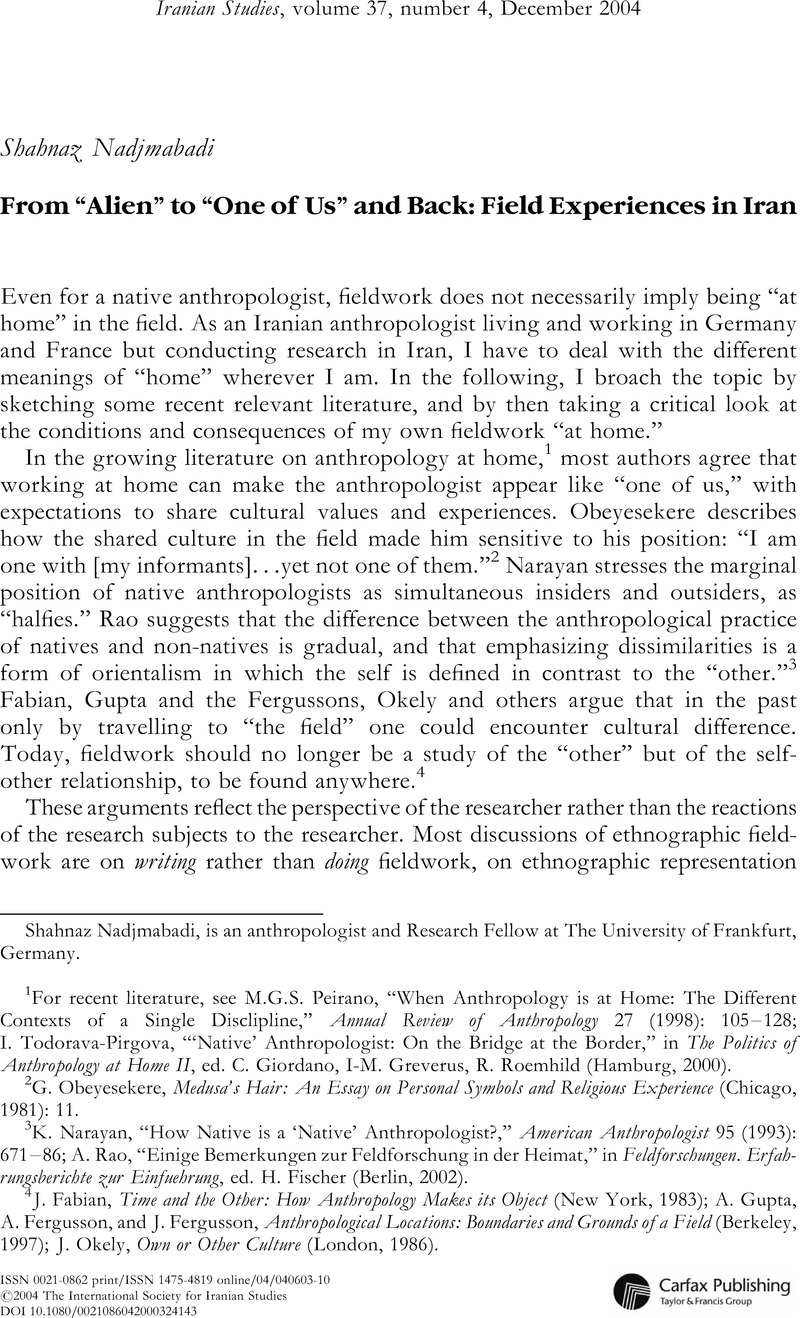Published online by Cambridge University Press: 01 January 2022

1 For recent literature, see Peirano, M.G.S., “When Anthropology is at Home: The Different Contexts of a Single Disclipline,” Annual Review of Anthropology 27 (1998): 105–128CrossRefGoogle Scholar; Todorava-Pirgova, I., “‘Native’ Anthropologist: On the Bridge at the Border,” in The Politics of Anthropology at Home II, ed. Giordano, C., Greverus, I-M., Roemhild, R. (Hamburg, 2000)Google Scholar.
2 Obeyesekere, G., Medusa's Hair: An Essay on Personal Symbols and Religious Experience (Chicago, 1981): 11CrossRefGoogle Scholar.
3 Narayan, K., “How Native is a ‘Native’ Anthropologist?,” American Anthropologist 95 (1993): 671–86CrossRefGoogle Scholar; Rao, A., “Einige Bemerkungen zur Feldforschung in der Heimat,” in Feldforschungen. Erfahrungsberichte zur Einfuehrung, ed. Fischer, H. (Berlin, 2002)Google Scholar.
4 Fabian, J., Time and the Other: How Anthropology Makes its Object (New York, 1983)Google Scholar; Gupta, A., Fergusson, A., and Fergusson, J., Anthropological Locations: Boundaries and Grounds of a Field (Berkeley, 1997)Google Scholar; Okely, J., Own or Other Culture (London, 1986)Google Scholar.
5 See also Fine, G. A., “Ten Lies of Ethnography: Moral Dilemmas of Field Research,” Journal of Contemporary Ethnography 22.3 (1993): 267–294CrossRefGoogle Scholar.
6 In Luristan, west-Iran (1970), in Khorasan, east-Iran (1976), and in the Iranian coastal region of the Persian Gulf (1977 to present).
7 Nadjmabadi, R. Shahnaz., “Die Shirawand in West Lorestan: mit besonderer Beruecksichtigung des Verwandtschaftssystems” (Ph.D. diss., University of Heidelberg, 1975)Google Scholar.
8 Qolam H. Saedi, a medical professional, wrote the first book about zar ceremonies, after a lengthy stay in the Gulf region. Saedi, Q.H., Ahl-hava (Tehran, 1966)Google Scholar.
9 For this see also Black-Michaud, Jacob, Sheep and Land: The Economics of Power in a Tribal Society (Paris, 1986)Google Scholar. He describes contractual relationships of the “Lure” as rigid. Digard, J.P., “Jeux de structures. Segmantarité et pouvoir chez les nomades Baxtiari d'Iran,” L'Homme 102 (1987): 12–53CrossRefGoogle Scholar describes the power distribution among the Bakhtiari as rigidly structured.
10 Douglas, J., Investigative Social Research: Individual and Team Field Research (Beverly Hills, CA, 1976): 131Google Scholar.